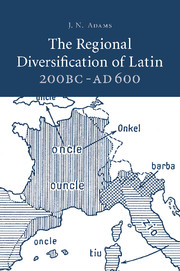Book contents
- Frontmatter
- Contents
- List of maps
- Preface
- List of abbreviations
- Chapter I Introduction
- Chapter II The Republic: inscriptions
- Chapter III Explicit evidence for regional variation: the Republic
- Chapter IV Explicit evidence: the Empire
- Chapter V Regionalisms in provincial texts: Gaul
- Chapter VI Spain
- Chapter VII Italy
- Chapter VIII Africa
- Chapter IX Britain
- Chapter X Inscriptions
- Chapter XI Conclusion
- Maps
- Bibliography
- Index verborum
- Subject index
- Index locorum
Chapter XI - Conclusion
Published online by Cambridge University Press: 22 September 2009
- Frontmatter
- Contents
- List of maps
- Preface
- List of abbreviations
- Chapter I Introduction
- Chapter II The Republic: inscriptions
- Chapter III Explicit evidence for regional variation: the Republic
- Chapter IV Explicit evidence: the Empire
- Chapter V Regionalisms in provincial texts: Gaul
- Chapter VI Spain
- Chapter VII Italy
- Chapter VIII Africa
- Chapter IX Britain
- Chapter X Inscriptions
- Chapter XI Conclusion
- Maps
- Bibliography
- Index verborum
- Subject index
- Index locorum
Summary
In this chapter I review some of the findings and themes of the book.
‘UNITARY’ AND ‘DIFFERENTIAL’ THEORIES
Väänänen (1983) pointed out that it is possible to distinguish between two theories that have been advanced to account for the transition from a single language, Latin, apparently without regional variations, to the regional diversity of Romance. He calls them (1983: 481) the ‘thèse unitaire’ and the ‘thèse différencielle’, the first favoured by Latinists and the second by Romance philologists. According to the first Latin showed no variations until very late. According to the second Latin had local variations ‘from the imperial period, and in any case well before 600’ (Väänänen 1983: 490). The metalinguistic evidence presented in this book makes nonsense of the unitarian thesis, and the differential thesis as formulated by Väänänen just quoted is itself not satisfactory, because the regional diversity of the language can be traced back at least to 200 BC and was not a new development of the Empire. That is not to say that the Romance languages were in any sense being foreshadowed already in 200 (though we will see some continuities below, 3.5). The patterns of local diversity in 200 were not the same as those to be found a millennium or more later, but the essential point is that the language always showed regional as well as social, educational and stylistic variations. The nature of the diversity was not static but went on changing.
- Type
- Chapter
- Information
- The Regional Diversification of Latin 200 BC - AD 600 , pp. 684 - 732Publisher: Cambridge University PressPrint publication year: 2007



